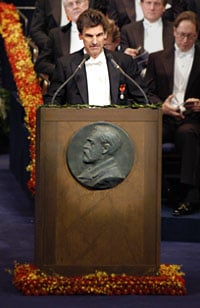Award ceremony speech

Professor Torsten Persson delivering the Presentation Speech for the 2003 Bank of Sweden Prize in Economic Sciences in Memory of Alfred Nobel at the Stockholm Concert Hall.
Copyright © Nobel Media AB 2003
Photo: Hans Mehlin
Presentation Speech by Professor Torsten Persson, the Royal Swedish Academy of Sciences, December 10, 2003.
Translation of the Swedish text.
Your Majesties, Your Royal Highnesses, Ladies and Gentlemen,
In modern society, every day of our lives the media deluge us with numbers on key economic variables: inflation, unemployment, interest rates, stock prices and much more. Most readers or viewers regard this information merely as quotations, more or less similar to weather reports. But researchers regard them as integral parts of a massive flow of data which, over time, gives rise to economic time series. Such time series are vital, not only for basic researchers who develop and test economic theory, but also for practitioners who require clear understanding and reliable forecasts as a basis for public policy or private decisions.
A prerequisite for the work of both researchers and practitioners is statistical methods that capture the special features of economic time series. Researchers in the borderland between economics and statistics have therefore made important contributions by devising new methods that avoid profound statistical pitfalls, or pave the way for novel research and entirely new applications.
In the 1980s, Clive Granger’s breakthrough solved a particularly difficult problem concerning the complex interplay among macroeconomic variables over time. For example, when analyzing the effects of households’ income and wealth on their consumption in the long run, it is difficult to distinguish adjustment towards a long-run relationship from short-run fluctuations in data. As we know, the value of wealth is highly affected by fluctuating share prices and property values. Moreover, like most macroeconomic variables, consumption, income and wealth do not fluctuate around given values over time, but around stochastic trends. When traditional statistical methods are applied to such nonstationary time series, the resulting relationships are often misleading, sometimes even nonsensical.
Granger succeeded in showing that systems of nonstationary variables are often driven by a single underlying common trend. He minted the term cointegration to describe such systems and demonstrated that cointegration provides a key to reliable statistical inference. Granger’s method has wholly transformed work with time series, among both researchers and forecasters. His methods provide powerful tools for economic analysis; they naturally separate the dynamics in an economic system into forces that generate adjustment to long-run equilibrium and forces that only lead to short-run fluctuations.
During the same period, Robert Engle worked on another aspect of time series, to some extent inspired by two earlier Laureates: Friedman and Lucas. Their research implied that uncertainty, volatility, in macroeconomic variables could shape economic relationships, such as the sensitivity of unemployment to inflation: the slope of the well-known Phillips curve. Engle interpreted volatility as the size of the random term in a statistical model, and devised the so-called ARCH method to trace systematic variations in volatility over time.
It soon became clear, however, that the principal applications of the method would be in financial economics rather than macroeconomics. Investors who choose between stocks and bonds, firms which try to determine the value of derivatives, banks which want to limit the risk of large capital losses, all require forecasts on the riskiness of returns, that is, their volatility. Time series for returns on stocks, bonds and currencies also exhibit distinct patterns. Turbulent periods with high volatility on markets are followed by calmer periods. Prior to the advent of ARCH methods, forecasts based on these volatility patterns were not possible. Engle’s breakthrough generated an entirely new research area, financial econometrics, and his methods are now indispensable tools for risk evaluation throughout the world. This is a striking example of basic research, stirred by curiosity, which engendered unexpected applications in wholly new areas.
Dear Professor Engle: Your contribution to economic sciences paved the way for the new field of financial econometrics. Your ARCH methods have unleashed a flood of applications, thereby helping investors in financial markets to forecast volatility and manage their risks.
Dear Professor Granger: Your contribution to economic sciences has transformed research and forecasting with macroeconomic time series. Your cointegration methods have given researchers and practitioners a statistical tool-kit to model and estimate economic dynamics.
It is a great honor and a privilege for me to convey to you, on behalf of the Royal Swedish Academy of Sciences, our warmest congratulations. I now ask you to receive the Prize from His Majesty the King.
